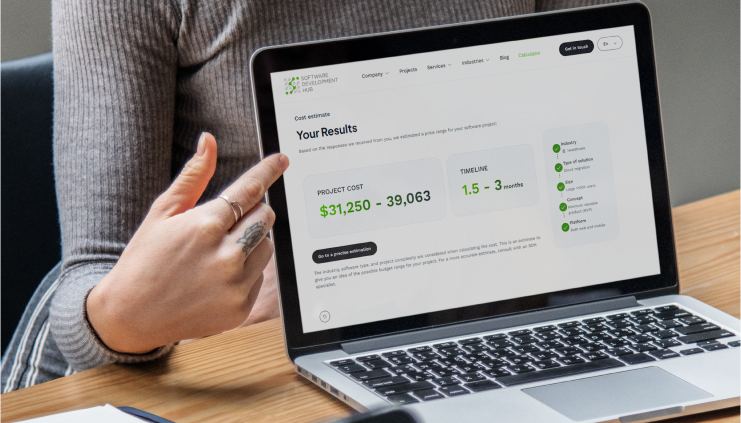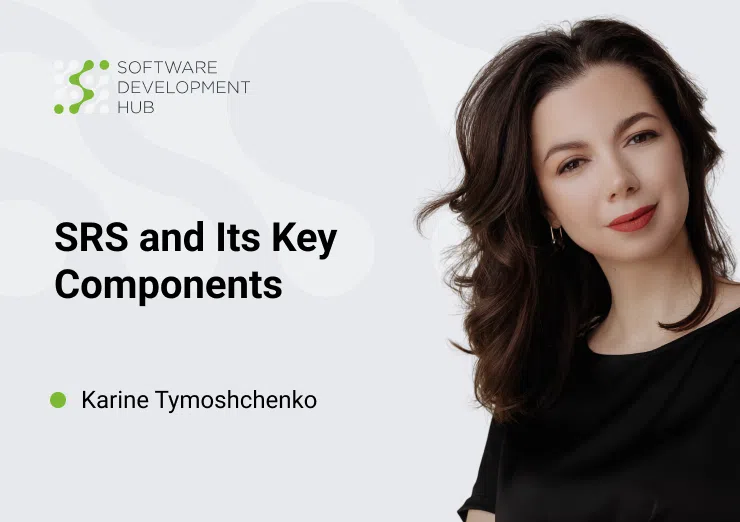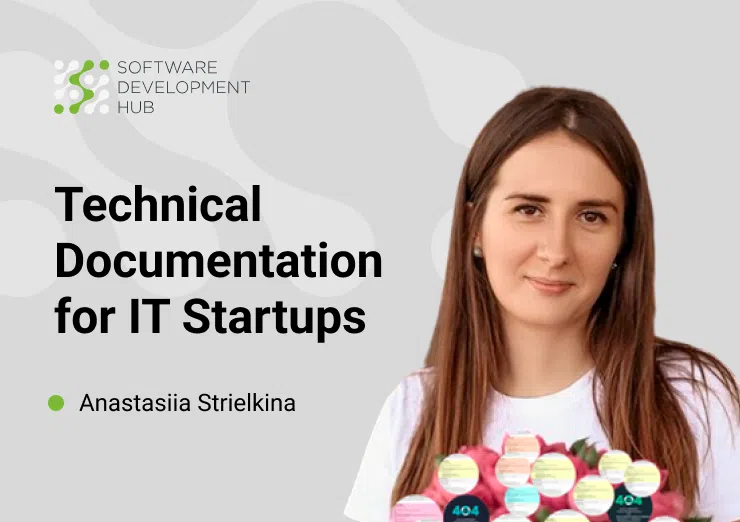How to build a Minimum Viable Product (MVP)
How can software startups succeed with minimal risks and costs in an environment where 90% of launched startups fail? Each project should start with a minimum viable product. This article will discuss the concept and stages of building an MVP.
Building an MVP implies finding the right balance between what the business offers to users and what users actually need. The MVP aims to test the hypothesis that the product will solve a user problem. MVPs also allow businesses to minimize errors in the development process. An MVP helps to collect high-quality feedback by targeting specific groups or user types.
92% of launched startups close, and every project should start with a minimally viable product. This article will discuss the concept and stages of building an MVP.
What is an MVP (Minimum Viable Product)?
According to a study by CB Insights Research,
- the new global funding record, up 157% year-over-year;
- 29% of startups fail because they run out of cash;
- startups that scale properly grow 20 times faster than those that scale prematurely.
But many startups, rather than seeing an influx of fresh capital, shut down altogether due to several factors, such as increased competition, a lack of market traction, and flawed business models. While these challenges may have been manageable on their own, in many cases, they proved to be fatal when compounded with pandemic-induced pressures.
In almost half of the cases, entrepreneurs spend months or even years of work only to realize that the hypothesis was wrong and no one is interested in their product.
The concept of Minimum Viable Product (MVP) is designed to minimize the risk of such a situation. It applies to the creation of any product but is more commonly used for software development and digital services.
The concept of MVP was coined and defined in 2001 by Frank Robinson and then popularized by Steve Blank and Eric Ries. Robinson defines MVP as the result of "synchronous development"— simultaneous product development and research of the target audience and its reaction to the product. An MVP is a version of a future project that collects the most actionable data about how customers interact with it at the lowest possible cost.
Business benefits of MVP development
Thus, a minimally viable product allows you to:
- test your idea before spending their entire budgets on things that may not work;
- confirm the viability of an idea and test product hypotheses with real data;
- identify trends that can be used in the development of the full version of the product;
- reduce the risk of major financial losses if the product fails;
- reduce development costs by prioritizing important and identifying unneeded features;
- speed up bug finding and internal testing of the product;
- to gather a user base before a full-scale launch;
- occupy a market niche and attract investors before competitors do it.
MVP tasks
MVP is created not for technology testing but to verify in practice whether the users need such a product, and whether the hypotheses underlying the business model are correct. The main purpose of the MVP is to minimize the time and effort spent on testing the market response to the idea.
Eric Ries defines it in the following way:
Minimum Viable Product is that version of a new product that allows a team to collect the maximum amount of validated learning about customers with the least effort.
- Starting with an MVP will allow you to learn more about your end-user and the market you wish to enter as you test your assumptions.
- MVP allows you to involve real users in the project as guides who help adjust the business model and basic characteristics of the future product, outline the directions of development and plan the roadmap for updates.
- Positive results at the MVP stage give the green light to develop the full version of the product.
MVP development follows a build-measure-learn process, which allows you to release a product that can be continually improved as you validate (or invalidate) assumptions, learn what users want, and build future iterations of your app that better serve your customers.
Creating an MVP: how to plan and implement an MVP?
To launch a minimally viable product, you need to go through eight preparatory steps. This part of the article presents a step-by-step process of MVP app development and describes each stage in all details.
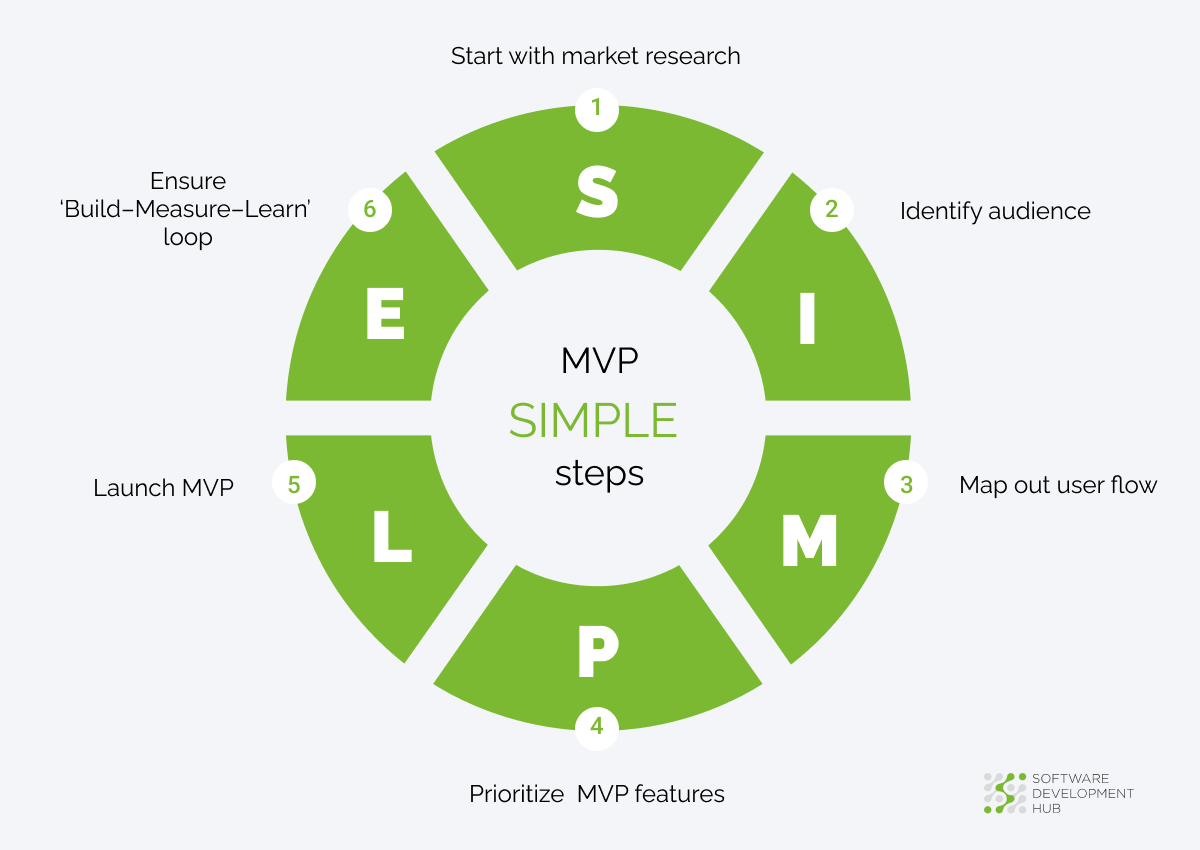
Step 1: Start with market research.
While building an MVP, it is necessary to think from the customer's perspective.
To understand that, two important questions must be asked.
- What problem are you trying to solve?
- And for whom?
Market research provides invaluable insights into customer needs. Every product is created to solve some problem, and it's not about making a profit. This requires a customer-oriented approach. What does the user need the product for?
If you articulate the answer clearly, you'll get an idea of the product's purpose and its value to the user. Surveys will help you analyze the market needs and where your product will fit. For example, by opening a short-term parking space rental service, you are solving the problem that all drivers face — making it easier to find a place to leave a car.
Step 2: Define the audience and identify its core.
Focusing on the needs of a broad audience when designing your MVP is a misguided strategy. Narrowing your target audience allows you to target your future product more accurately. To do this, you should formulate the portrait of the "ideal" user, the one who will buy your solution without hesitation and will be happy with its features.
Such a portrait usually includes information on the user's age, education level, income, habits, interests, and hobbies. These details are needed to understand how well the product suits the future user and will help later at the stage of advertising and promotion.
Step 3: Map out user flow
The design process is an important MVP stage. A user flow is the order of steps a user takes to reach his goal, such as purchasing a product or finding and renting a parking space.
The processes (stages) in using the app/product must comply with user flow. Always make the convenience of users the priority while designing the processes and user flow. Construct the MVP using a simple user flow without adding unnecessary features. The focus should be made mainly on basic tasks such as finding and buying the product or managing and receiving orders rather than features.
Thinking about how the user interacts with the future application, you will understand at what stage you should provide additional information, where to add a hint and how to optimally design the interface.
Step 4: Identify the main features to implement and calculate the volume of MVP
No matter how large a project is in your mind, you need to list and prioritize features for the MVP. When building a Minimum Viable Product, preference is given to those that are directly related to the main purpose of the future product.
Introducing additional features into the prototype will only confuse users and reduce the validity of the business idea research results. They can be added only after the MVP has been deployed and the initial feedback has been collected and analyzed.
This step helps you identify where you can make the most impact on the urgency of the feature. Categorize the features into different lists: high priority, medium priority, low priority, etc., and decide which ones to use in your first version i.e., the MVP. Using a prioritization matrix, you can decide what absolutely needs to be included in your MVP and what features can be included in later releases. Below is our recommended format for your MVP prioritization matrix.
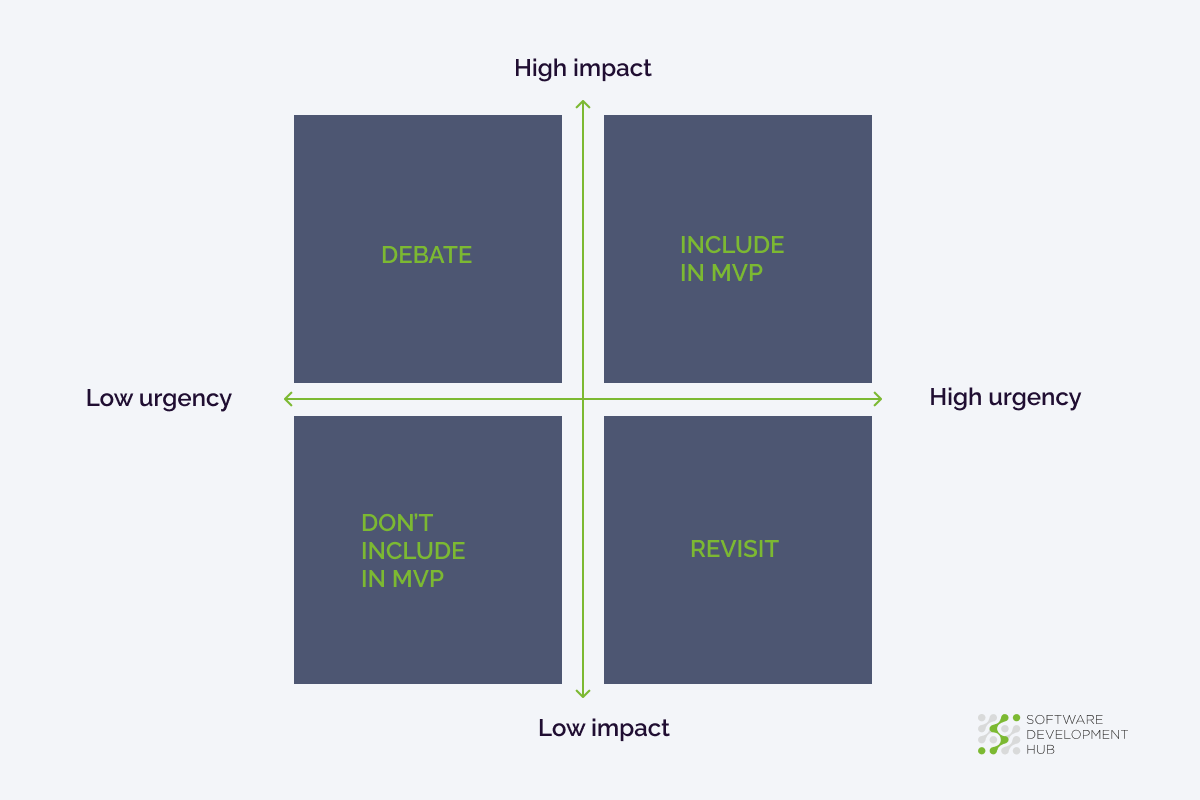
Let’s take a look at some examples of MVP features depending on their types.
eCommerce MVP app development
- Payment options
- Product, category, and subcategory pages
- Online shopping cart
- Order history
- Product information and parameters
Educational MVP software development
- Scheduling
- Course page
- Audio and video streaming
- Tests
- Progress measuring
- Messaging
- Ratings
Food delivery MVP development
Customer app:
- Geolocation
- Order list management
- Payment with a credit card
- Search for restaurants and foods
- View restaurant profile and menu
- Cart management
- Notifications about order status
Courier app:
- Tasks and their status
- Balance dashboard
Social network MVP features
- Feed
- Create posts
- Like and comment on posts
- Manage friends
- Report content or users
- Event-based notifications
Taxi booking app development
Driver app:
- Accept or decline booking requests
- Status updates
- Orders history
- Geolocation
- Passenger rating
Passenger app:
- Ride requesting
- Pickup locations and driver tracking
- Fate calculator
- In-app payment
- Booking history
- Drivers' reviews and rating
Healthcare MVP software development
- Scheduling appointments
- In-app payment
- Access to medical records
- Checking and downloading tests results
- Reviews
- Live chat with doctors
- Schedule management
- Test reports uploading
- Chats with patients
- Chats with other doctors
- Patient management
Step 5: Launch the MVP or MVP implementation
Once the scope, order, and direction of work have been determined, you can begin to develop a minimum viable product.
1) Choose the right methodology
How the development process is structured will largely determine the outcome. For the MVP, it is fundamentally important to use one of the iterative approaches to development. Kanban/Agile/Scrum/Lean — all of them allow you to organize regular updates, and improve the product "on the fly", as the feedback comes. The choice of a particular methodology depends on the preferences of the development team and the specifics of a particular project.
2) Design
Note: the stage is reasonable only if the design is a competitive advantage; otherwise, it’s better to use default themes and focus on the MVP functionality.
Sketches, usually created in free-hand format, are a great solution to present your idea to investors or to start a crowdfunding process.
Mockups and wireframes provide a more detailed representation of the future product with the location of system elements, navigation method among screens, and other product features. It’s a great approach if you want to test some really innovative features that will change the behavior pattern for users.
3) Development (coding)
At this stage, the development of an MVP happens. Time is a crucial factor at this stage. The faster you develop a software-based MVP and deliver it to the market, the better.
4) Testing
An MVP product requires regular testing throughout development.
Alpha testing is done internally by the testing team, but beta testing will require outside help. It is good if these are people from among the future users. The main task of testing will be a technical improvement of the MVP. Before release, the product must work without bugs, so that problems of a technical nature do not prevent users from evaluating its functionality.
The beta testing period lasts around 1-2 weeks. Measure the key indicators and understand the changes required. According to feedback received from beta testing, make changes accordingly in the next version.
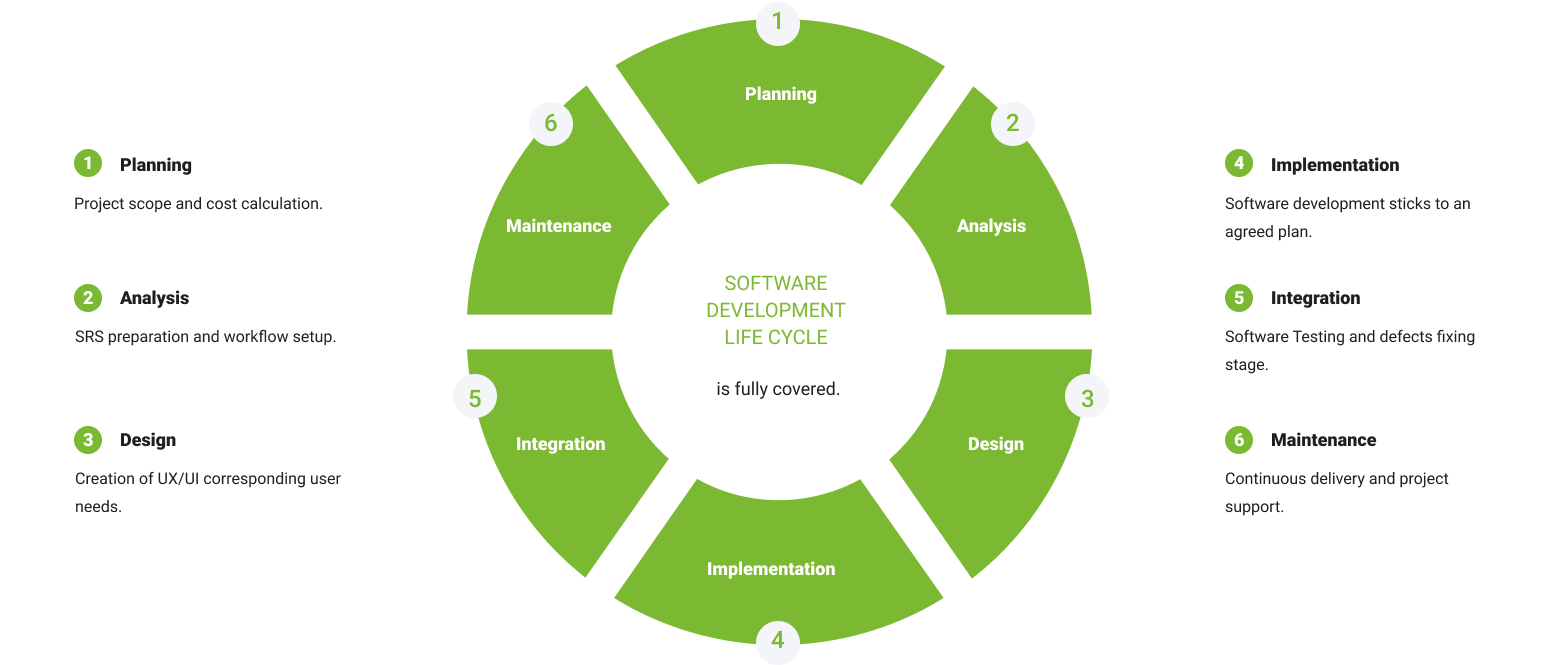
Step 6: Build. Measure. Learn. Repeat
For the project team, the work has just begun. From the moment of launch, feedback has to be collected, stored, and analyzed, from statistics to data on user behavior and feedback.
The Build-Measure-Learn (BML) technique comes from the Lean Startup methodology. Using this approach, you make the development process efficient. It is a learning cycle of turning ideas into products, measuring customers' reactions and behaviors against built products, and then deciding whether to persevere or pivot the idea; this process repeats as many times as necessary.
The phases of the loop are: Ideas → Build → Product → Measure → Data → Learn.
The data gathered by MVP will help to understand if the project has perspectives, will help generate new ideas, and will create a product development strategy based not on suppositions but on facts. Thus MVP testing pays off.
Our experience allows us to evaluate the data and analyze customer feedback. We understand that launching the MVP, testing the product, and processing the feedback are complicated and costly tasks which require a professional approach.
Timeline for a software-based MVP development
In mobile app development, an MVP is a method where you only develop the core functionalities to solve a specific problem and satisfy early adopters. Essentially, an MVP is the basic model of your product that will fulfill the primary goal you want to achieve.
MVP Business Analysis
(20-40 h)
The stage includes identifying business needs, target market, customer, and competitor research, product idea generation, planning a KPI dashboard for MVP, etc.
MVP UX design
(10-30 h)
UI designers' main result is following basic business logic concepts, syncing with the UX designer's wireframes, and creating an engaging and convenient interface.
MVP UI design
(20-40 h)
Mobile and web app UI designers are in charge of the visual look of the application - shapes, surfaces, shading, consistency, visual appearance of the project because of the UX provided.
MVP coding
(2-6 months ≈ 240-720 h)
Front-end development to transform static interface images provided by UI designers into a fully functional MVP client-side, and ensure its communication with the server.
To bring the MVP to life is the job of a back-end engineer, who is responsible for the server side of MVP development.
A DevOps engineer ensures an MVP's scalability, stability, and security.
MVP testing
A QA engineer identifies bugs and potential problems, plans and performs tests during the development process, and recommends what improvements should be made. Testing runs in parallel with development.
As a result of the development team's work, you get an MVP ready for launch.
How much does MVP development cost?
|
Cost for Software by Type |
Filling |
Average Cost |
Amount of Time Allocated |
|
For simple MVP software development |
Basic-functional MVP, primary interface, one platform |
$25 000 - $50 000 |
2-3 months |
|
For medium-complexity MVP software development |
Comprehensive functions, specific interface, one platform |
$50 000 - $120 000 |
3-6 months |
|
For an MVP comprehensive app |
Advanced high-level features, custom-designed interface |
$120 000 - $250 000 |
6-9 months and more |
Now let's be more precise. If we take an average development rate of $50/hour, creating basic-features software will cost around $25,000. More complicated products will cost $50,000, but the most complex ones will cost less than $120,000.
However, the cost of developing a mobile or web application depends on the regions where the contractor company is registered too. For example, in North America, performers work for $150/hour for both iOS and Android. In Australia, the price tag drops to $92, while developers in Central European countries charge around $40 per hour on average. This, in part, is the reason why customers from the USA and Western Europe often request MVP development outsourcing from companies in Eastern Europe. With 100+ motivated engineers, Software Development Hub offers MVP development services to plan and deliver tailored quality software reliably and promptly.
What skills are needed to build an MVP?
- Project Manager
- Business Analyst (BA)
- UX Designer
- UI Designer
- Back-end developers (1-3)
- Front-end developer
- Quality Assurance Engineer
Software Development Hub solves the challenges of small and mid-sized businesses. Relying on our values, we deliver software from a raw idea to a market-ready solution or improve existing projects.
MVP development consulting
- Assistance in conceptualizing your idea.
- Pre-project preparation and business analysis.
- Define the functionality of the MVP.
- Software requirements specification.
- Define the technology stack and architecture of the MVP.
- Providing a detailed roadmap for MVP implementation.
End-to-end MVP development
- Product/project management and BA.
- UX and UI MVP design.
- MVP development.
- Integration with third-party systems.
- MVP testing.
- MVP launch and support.
- MVP performance evaluation and further iterations.
Software Development Hub has considerable consulting and startup development experience, including IT startups related to innovative technologies, at the early stages of their formation (pre-seed, seed, and series A).
Get ahead of costs: try our MVP development cost estimator.
Categories
Share
Need a project estimate?
Drop us a line, and we provide you with a qualified consultation.




